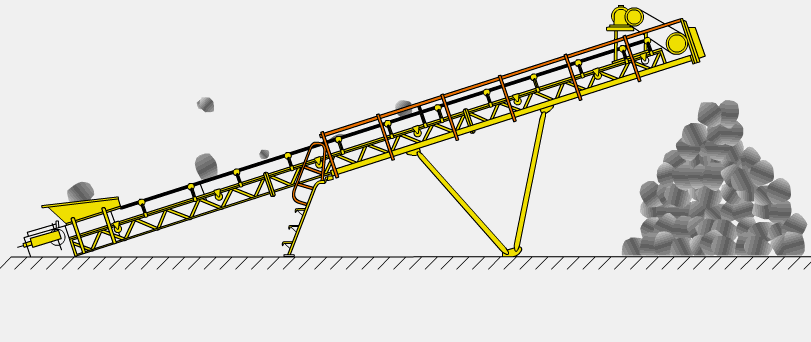
【Production Capacity】10-200 tons per hour
【Feed particle size】0-8''
【Power system】Motor or Diesel engine
【Applicable materials】rock quarries, sand and gravel, mining, construction and demolition recycling, construction aggregates, coal,road and railway construction, metallurgy, water conservancy, and chemical industry.
【Price】$1000--$10000USD
Overview
Aggregate conveyor systems, often called "conveyors," are integral to material handling systems. They are designed to transport bulk materials, such as aggregates, gravel, sand, or even heavy-duty construction materials, efficiently and continuously from one location to another.
Introcuction
These conveyor belt for crushers play a vital role in various industries, ensuring the seamless movement of materials across job sites, production facilities, and storage areas.
You can even purchase a custom-designed conveyor if your operation has particular needs. Remember that finding replacement parts in your local repair shop may be challenging with a custom-designed machine.
Conveyor belts are essential in the construction industry, used to transport materials such as concrete, bricks, and lumber. They can even be used to transport machinery and equipment, as well as to sort and distribute materials. This all helps improve productivity, efficiency, and safety, while reducing the need for manual labor.
Conveyor belt for crusher in quarries and mining. Applications include sand and gravel conveyor belts, crushed stone conveyor belts, and conveyor belts for hard rock, limestone, ore, dirt, stone, and other aggregates. Overlays, sub-layers, and reinforcement layers are designed to achieve the optimal durability, wear, and tear resistance required by this industry.
Our belt conveyor is mainly used for transporting aggregates; it can also be used for transporting many other things, such as salt, ore, sand, coal, mineral, chemical, power plant, metallurgy.
The belt conveyor is suitable for bulk grain conveying, stacking, loading, and unloading operations.
Working principle
How does an aggregate BELT CONVEYOR SYSTEM work?
At the heart of a conveyor belt lies a conveyor system, a mechanical apparatus with a continuous belt that rotates around a series of pulleys.
The belt is specifically designed to carry bulk materials, and it operates by being driven by an electric motor, engine, or other power sources.
The material to be transported is loaded onto the conveyor at one end and then moved along the belt to its destination, where the unloading will occur.
The key components of an aggregate conveyor system include:
Belt
The conveyor belt is the system's backbone, providing a stable surface for moving materials. Different belt widths are available to accommodate various types and quantities of materials.
Pulleys
Pulleys are used to support and guide the conveyor belt. There are both drive pulleys, which provide power to the belt, and idler pulleys, which maintain belt tension and alignment.
Drive Mechanism
The drive mechanism, typically an electric motor or engine, powers the conveyor by turning one of the drive pulleys. The horsepower of the drive mechanism will vary depending on the weight of the materials it needs to carry.
Performance characteristics
1. Lower longitudinal elongation.
2 . Full resistance to mildew, moisture, and rotting.
3 . Good flexibility and toughness.
4. Short take-up lengths.
5 . Suitable for middle and long-distance transportation of higher loads and speeds.
6 . Aggregate conveyors are the unsung heroes of various industries, silently but efficiently moving bulk materials from one point to another.
Understanding their role, mechanics, and diverse applications underscores their importance in modern material handling processes. From construction to mining, manufacturing to agriculture, and beyond, aggregate conveyors are indispensable tools that enhance efficiency, reduce labor costs, and contribute to the seamless flow of materials in various industries.
Technical Parameters
| Model | Conveying Distance (m) Power (kw) | Conveying Speed(m/s) | Capacity (m/s) | ||
| B400 | ≤12m | 12-20m | 20-25m | 1.9-2.1 | 20-60 |
| 1.5kw | 2.2-4kw | 3.5-7.5kw | |||
| B600 | ≤12m | 12-20m | 20-25m | 1.9-2.1 | 60-120 |
| 4kw | 5.5kw | 5.5-7.5kw | |||
| B800 | ≤10m | 12-20m | 20-25m | 1.9-2.1 | 120-200 |
| 4kw | 5.5kw | 5.5-11kw | |||
| B1000 | ≤10m | 12-20m | 20-25m | 1.9-2.1 | 200-400 |
| 5.5kw | 7.5-11kw | 7.5-15kw | |||
| B1200 | ≤10m | 12-20m | 20-25m | 1.9-2.1 | 400-600 |
| 7.5kw | 11kw | 11-18kw | |||
Note: Technical data are subject to change without prior notice.

Contact: Hebe Wang
Phone: +86 150 9289 4665
Tel: +86 150 9289 4665
Email: info@sandmancrusher.com
Add: No.23 Yihe Road,Linyi City, Shandong Province, China
We chat